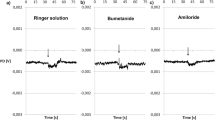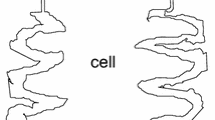Summary
A procedure that allows areas up to 1 cm2 of the epithelium to be separated from the corium of the toad skin is described. For several hours the preparation maintains the transport characteristics of the isolated intact skin, namely electrical potential differences up to 100 mV (outer side negative) and short-circuit currents up to 80 μAmp/cm2, which are equal to the net Na fluxes. The isolated epithelium responds well to antidiuretic hormone. Microelectrode impalement is easier than in the intact skin. The most negative stable electrical potential level within the epithelium is recorded immediately below the first corneal layer, at 5–15 μ from the outer surface. From that site outwards, the highest epithelial resistance is measured across structures that are mainly Na-permeable and less K-permeable and which repsond to ADH with a diminution of their resistance. The structures located from that site inwards (the internal 30–40 μ of the epithelium) are highly permeable to K. The region of high K permeability does not seem to be localized at only one site near the basement membrane, but distributed across several cell layers of the deeper strata.
Similar content being viewed by others
References
Aceves, J., Erlij, D.: The effects of ouabain and antidiuretic hormone on Na uptake by the isolated epithelium of the frog skin. Abstract Third International Biophysics Congress, Cambridge, Mass., Aug. 28–Sept. 3 (1969).
Cereijido, M., Curran, P. F.: Intracellular electrical potentials in frog skin. J. gen. Physiol.48, 543 (1965).
Chowdhury, T. K., Snell, F. M.: A microelectrode study of electrical potentials in frog skin and toad bladder. Biochim. biophys. Acta (Amst.)94, 461 (1965).
Curran, P. F.: Letter to the editor. J. gen. Physiol.47, 1251 (1964).
—, Cereijido, M.: Potassium fluxes in frog skin. J. gen. Physiol.48, 1011 (1965)
Engbaek, L., Hoshiko, T.: Electric potential gradients through frog skin. Acta physiol. scand.39, 348 (1957).
Erlij, D., Aceves, J.: Sodium transport across the isolated epithelium of the frog skin. Biophys. J.9, A 163 (1969).
Farquhar, M. G., Palade, G. E.: Cell junctions in amphibian skin. J. Cell Biol.26, 263 (1965).
——: Adenosine triphosphatase localization in amphibian epidermis. J. Cell Biol.30, 359 (1966).
Hoshiko, T., Lindley, B. D., Edwards, C.: Diffusion delay in frog skin connective tissue: A source of error in tracer investigation. Nature (Lond.)201, 932 (1964).
Kidder, G. W., Cereijido, M., Curran, P. F.: Transient changes in electrical potential differences across frog skin. Amer. J. Physiol.207, 935 (1964).
Lindemann, B., Thorns, U.: Fast potential spike of frog skin generated at the outer surface of the e0ithelium. Science158, 1473 (1967).
Ottoson, D., Sjöstrand, F., Stenström, S., Svaetichin, G.: Microelectrode studies on the EMF of frog skin related to electron microscopy of the dermo-epidermal junction. Acta physiol. scand.29, Suppl. 106, 611 (1953).
Rawlins, F.: Acción de la hormona antidiurética sobre las resistencias eléctricas del epitelio aislado de la piel de Bufo marinus. Universidad Central de Venezuela, Facultad de Ciencias, Tesis de Licenciado en Biología (1967).
Scheer, B. T., Mumbach, M. W.: The locus of the electromotive force in frog skin. J. cell. comp. Physiol.55, 259 (1960).
Skjelkvale, L., Nieder, V. K., Huf, E. G.: Metabolic studies on frog skin epithelium. J. cell. comp. Physiol.56, 43 (1960).
Ussing, H. H.: Transport of electrolytes and water across epithelia. Harvey Lect.59, 1 (1963).
—, Windhager, E. E.: Nature of shunt path and active Na transport path through frog skin epithelium. Acta physiol. scand.61, 484 (1964).
—, Zerahn, K.: Active transport of Na as the source of electric current in the short-circuited isolated frog skin. Acta physiol. scand.23, 110 (1951).
Villegas, G. M., Fernandez, J.: Permeability to thorium dioxide of the intercellular spaces of the frog cerebral hemisphere. Exp. Neurol.15, 18 (1966).
—, Villegas, R.: Extracellular pathways in the peripheral nerve fibres: Schwanncell-layer permeability to thorium dioxide. Biochim. biophys. Acta (Amst.)88, 231 (1964).
Voûte, C. L.: An electron microscopic study of the skin of the frog (Rana pipiens). J. Ultrastruct. Res.9, 497 (1963).
—, Ussing, H. H.: Some morphological aspects of active Na transport. J. Cell Biol.36, 625 (1968).
Whittembury, G.: Electrical potential profile of the toad skin epithelium. J. gen. Physiol.47, 795 (1964).
Whittembury, G., Fragachan, F., Rawlins, F.: Action of antidiuretic hormone on the DC resistances of the isolated toad skin. Biophysical Society Ninth Annual Meeting, Abstract FA1 (1965).
Whittembury, G., Herrera, F. C.: Potential difference profile of the toad skin epithelium. Biophysical Society Seventh Annual Meeting, Abstract TC3 (1963).
Winn, P. M., Smith, T. E., Campbell, A. D., Huf, E. G.: Sodium diffusion in epidermis and corium of frog skin and in Ringer-agar gel. J. cell. comp. Physiol.64, 371 (1964).
Author information
Authors and Affiliations
Rights and permissions
About this article
Cite this article
Rawlins, F., Mateu, L., Fragachan, F. et al. Isolated toad skin epithelium: Transport characteristics. Pflugers Arch. 316, 64–80 (1970). https://doi.org/10.1007/BF00587897
Received:
Issue Date:
DOI: https://doi.org/10.1007/BF00587897
Key-Words
- Toad Skin Epithelium
- Active Sodium Transport
- Antidiuretic Hormone
- Transport Epithelia
- Structure and Function




